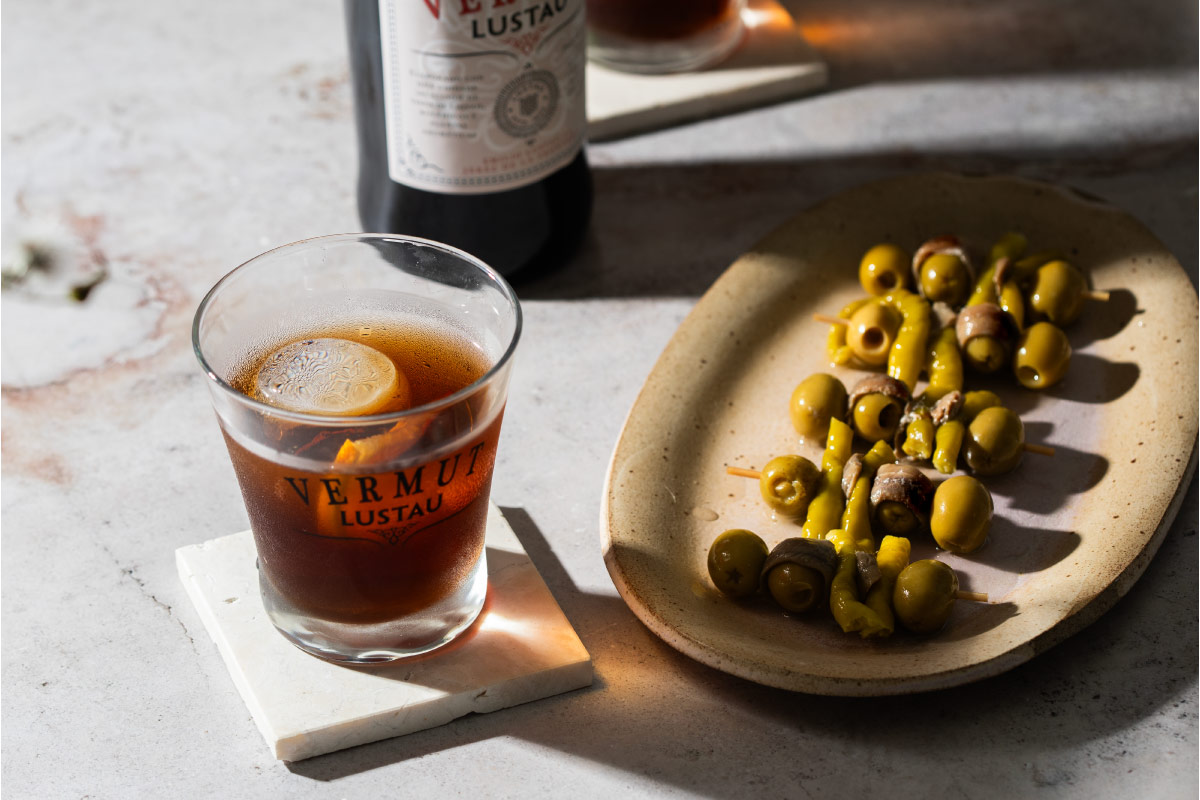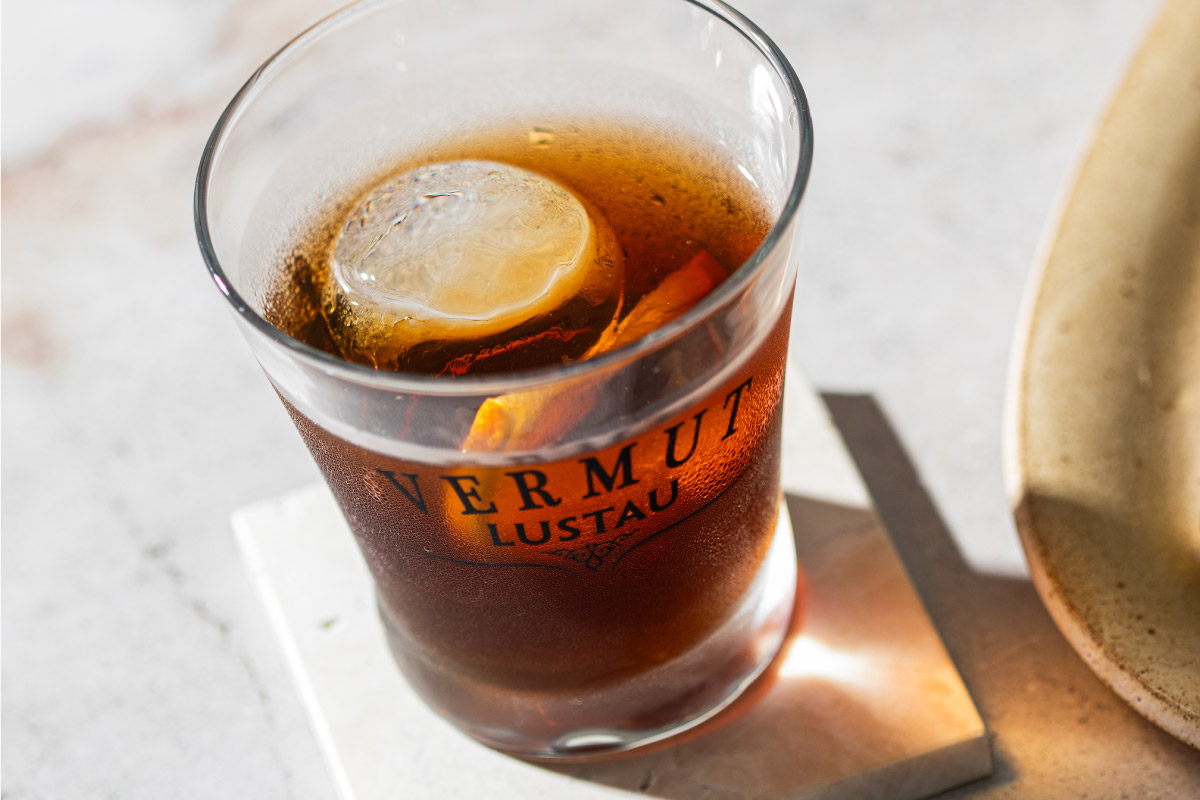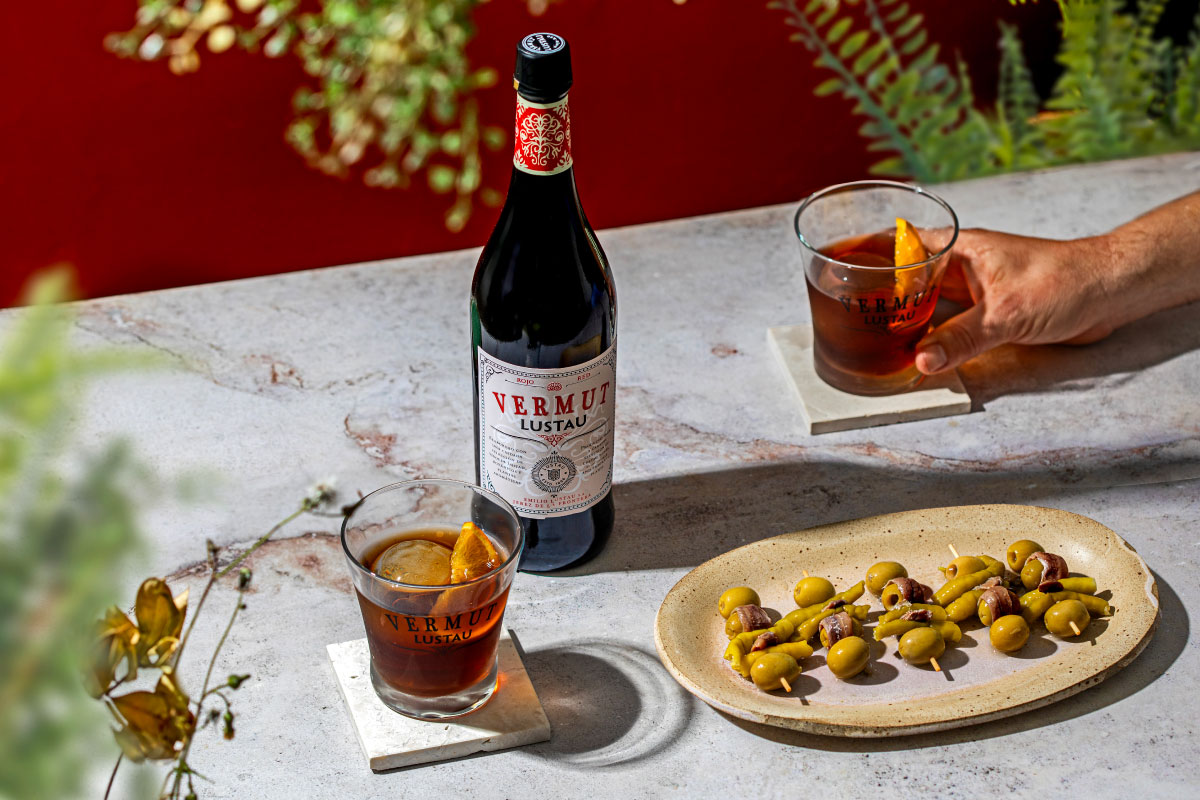Whether you’ve encountered them in a pintxo bar in San Sebastián or spotted them on a tapas menu elsewhere, Spanish gildas are small, bold, and unforgettable. This classic skewer of green olives, pickled guindilla peppers, and anchovies delivers a punch of briny, savory intensity in just one bite. Pair it with the right vermouth, and you’ll have one of the most iconic combinations in Spanish aperitivo culture.
In this guide, we’ll walk through how to pair gildas with vermouth, explore what makes the combination so satisfying, and show you how to recreate it at home. Whether you’re new to tapas or looking to refine your pairing skills, this article will help you enjoy gildas and vermouth the way they were meant to be: simply, traditionally, and with flavor in mind.
If you are into briny flavors you will love the combination between manzanilla en rama and your own made pickles. Learn more about this timeless pairing
WHAT ARE SPANISH GILDAS?
Gildas are a classic Spanish tapa made from three ingredients skewered on a toothpick: green olives, pickled green chili peppers (often guindillas), and anchovies. Small but packed with flavor, they combine saltiness, acidity, and umami in one bracing bite. Originally from the Basque Country, gildas have become a staple of bars and aperitivo tables throughout Spain—especially when paired with vermouth. Their punchy flavor profile makes them a natural companion to bold, bittersweet drinks, offering a quick but memorable food-and-wine moment.

HISTORY AND ORIGINS OF GILDAS
The gilda was born in San Sebastián sometime in the mid-20th century. Legend says the combination first came together informally at a local bar, where customers began skewering anchovies, olives, and peppers together to enjoy with drinks. The name “gilda” is said to come from Rita Hayworth’s character in the 1946 film Gilda—bold, salty, and a little spicy. The name stuck, and the tradition took off. Over time, gildas became one of the most recognizable and beloved pintxos in Spain, especially in the Basque region.
KEY INGREDIENTS IN A TRADITIONAL GILDA
A classic gilda requires just three ingredients, but quality is essential. Firm green olives—typically Manzanilla or similar brined varieties—form the base, paired with pickled green peppers such as guindillas for their mild heat and bright acidity. The final touch is a salt-cured anchovy, delivering deep umami flavor that balances the brine and tang of the other components.
WHY GILDAS ARE A STAPLE IN SPANISH TAPAS CULTURE
Gildas embody the essence of Spanish tapas: bold flavor, minimal fuss, and made for sharing. Their strong, briny bite makes them an ideal match for aperitifs like vermouth or fino sherry, and their small size makes them easy to serve at bars or at home. They’re satisfying without being heavy, and they set the stage for the rest of the meal. Over time, gildas have become more than just a snack—they’re a symbol of Spanish bar culture and a go-to pairing for those who love vermouth and tapas done right.
Learn more about en rama wines
WHY VERMOUTH IS THE PERFECT MATCH FOR SPANISH GILDAS
The pairing of Spanish gildas and vermouth is more than tradition—it’s a case of natural balance. Gildas are bold and assertive, while vermouth brings structure, herbal freshness, and a touch of sweetness. Together, they create contrast and harmony: salt against spice, umami against bitterness, acidity against warmth. In the Spanish aperitivo hour, this duo has stood the test of time. Whether enjoyed at a bar in San Sebastián or recreated at home, pairing gildas with vermouth is one of the simplest and most satisfying ways to begin a meal.
WHAT IS THE BEST VERMOUTH TO PAIR WITH SPANISH GILDAS?
While personal taste plays a role, most traditional Spanish pairings lean toward red vermouth (vermut rojo), (insertar link a Vermouth In Depth) which offers a bittersweet backbone that holds up to the punchy intensity of the gilda. Look for vermouths with herbal, spiced, and citrus notes—qualities that echo and enhance the gilda’s flavors.
Vermut Lustau Rojo, with its base of amontillado and pedro ximénez wines, is particularly well-suited. Its balance of sweetness, acidity, and spice complements the gilda’s saltiness and brine without overpowering it. For a lighter profile, a white vermouth (like Vermut Lustau Blanco) can work too, offering floral and slightly bitter tones that highlight the olive and anchovy.
HOW VERMOUTH ENHANCES THE FLAVORS OF GILDAS
Gildas are intensely flavorful—anchovies bring umami and salt, peppers add acidity and a hint of heat, and olives provide a firm, briny base. Vermouth cuts through this richness with bitter herbs and subtle sweetness, refreshing the palate between bites.
The wine-based nature of vermouth also helps bridge all the components of the gilda. Its fortified strength lifts the anchovy’s depth, while its botanical complexity interacts with the pickled pepper and olive to extend flavor in the mouth. Rather than clashing, vermouth brings cohesion—tying everything together with each sip.
CREATING A BALANCED TASTE EXPERIENCE WITH VERMOUTH
Balance is key to any great pairing. Gildas offer intensity in every bite, so the goal is to find a vermouth that matches their presence without overshadowing them. Serve your vermouth chilled, over ice with a slice of orange or an olive to mirror the ingredients on the skewer. The result? A bite and sip that feel connected—each refreshing the other. Whether it’s an informal aperitivo or the start of a multi-course meal, Pairing Spanish gildas with vermouth offers a small but rewarding moment of flavor precision.

HOW TO MAKE SPANISH GILDAS AT HOME
One of the best things about Spanish gildas is how easy they are to prepare. With just a few ingredients and minimal equipment, you can recreate this classic tapa in your own kitchen. Whether for a quiet aperitivo or a casual gathering with friends, gildas bring lots of flavor without much effort. And when paired with a good Spanish vermouth, they create an experience that feels both traditional and timeless.
To make classic gildas at home, all you need are three ingredients and toothpicks or cocktail skewers:
• Green olives – Choose firm, briny varieties like Manzanilla or Gordal.
• Pickled green peppers – Guindilla peppers are ideal. If unavailable, use other mild pickled green chilies with a bit of tang.
• Anchovy fillets – Salt-cured anchovies packed in olive oil work best; avoid overly vinegary varieties.
For the most balanced flavor, use high-quality ingredients packed in oil or brine—never dry or overly acidic versions.
STEP-BY-STEP GUIDE TO ASSEMBLING GILDAS
Ingredient List
1. Start with a toothpick or cocktail skewer.
2. Skewer one green olive.
3. Fold a pickled green pepper in half (or more, if long), and slide it onto the skewer.
4. Add one anchovy fillet, folded gently to stay secure on the skewer.
5. Finish with another olive (optional), or keep it simple with just one of each ingredient.
Repeat until you have a tray full of gildas, and keep chilled until serving. For best results, prepare them just before guests arrive.
Tips for Perfecting Your Gilda Recipe
• Use skewers that hold all ingredients firmly so they don’t slide apart when served.
• Don’t rinse the anchovies—their oil enhances the flavor and adds richness.
• For variety, you can experiment with stuffed olives, smoked anchovies, or even a splash of olive oil and lemon zest over the finished skewers.
• Serve cold, alongside a glass of chilled vermouth.
Gildas are best enjoyed fresh, in one or two bites—bold, briny, and always ready for another round.
PAIRING SPANISH GILDAS WITH VERMOUTH: A STEP-BY-STEP GUIDE
While pairing gildas with vermouth may seem instinctive in Spain, recreating that harmony at home is just as rewarding. The key is balance—between salt and sweetness, acidity and bitterness. A good pairing lets both the drink and the bite complement each other without competing. Whether you’re serving a few skewers before lunch or preparing an aperitivo board for guests, taking a little time to consider the right vermouth can elevate the entire experience.

Serving Tips for the Perfect Pairing<
• Chill your vermouth well before serving—ideally between 8–10°C (46–50°F).
• Serve over ice in a small tumbler or wine glass.
• Garnish with a slice of orange or a green olive, echoing ingredients in the gilda itself.
• Present gildas on a small platter or pinxto board, drizzled lightly with olive oil if desired.
• Pair one gilda per glass, allowing the flavors to build side by side without overwhelming the palate.
This simple but thoughtful setup brings out the best in both the food and the drink—delivering a full aperitivo experience with just a few ingredients.
CHOOSING THE RIGHT VERMOUTH FOR YOUR GILDAS
For traditional pairings, red vermouth (vermut rojo) is the go-to. Its richer body and bittersweet notes stand up well to the anchovy’s intensity and the acidity of the pepper. Vermut Lustau Rojo is a prime example—its amontillado and pedro ximénez base adds complexity, while the infused botanicals bring structure and spice.
If you prefer something lighter or more floral, vermut blanco also works—especially with milder gildas or when using stuffed olives or white anchovies (boquerones). Look for a vermouth that has both acidity and depth, so it can refresh the palate without fading next to the gilda’s boldness.
FREQUENTLY ASKED QUESTIONS ABOUT SPANISH GILDAS AND VERMOUTH
If you’re new to pairing gildas and vermouth, or curious about variations, storage, or substitutions, this section answers the most common questions about this beloved Spanish pairing.
What makes vermouth a great pairing for Gildas?
Vermouth balances the intensity of gildas with its bittersweet flavor, herbal complexity, and refreshing acidity. The anchovy’s saltiness, the olive’s brine, and the pepper’s tang all meet their match in vermouth’s rounded structure. A red vermouth adds richness and depth, while a white vermouth provides lift and contrast. Both cut through the oiliness of the fish and highlight the brightness of the pickled ingredients.
Can I use other drinks to pair with Gildas?
Yes, though vermouth is traditional, other options work too. Light, crisp white wines—like Fino or manzanilla sherry also pair well with gildas, offering similar dryness and salinity complementing the gilda’s intense profile. Avoid wines that are overly fruity or tannic, as they may clash with the anchovy and vinegar components.
Are Gildas healthy to eat?
Gildas are naturally low in carbohydrates and high in protein and healthy fats. Anchovies provide omega-3s, olives contain beneficial monounsaturated fats, and pickled peppers are low in calories. They are, however, relatively high in sodium—so moderation is key. As part of a balanced diet, gildas make a flavorful and satisfying snack.
What are some variations of the classic Gilda recipe?
While the traditional combination remains the most iconic, some variations include:
• Boquerones (white anchovies) for a milder, vinegar-forward bite
• Stuffed olives with anchovy, lemon, or cheese
• Cherry tomatoes added to the skewer for sweetness
• Pickled piparras instead of guindillas for less heat
• A splash of olive oil and lemon zest just before serving for added brightness
Feel free to adjust the ingredients to suit your palate while keeping the spirit of the gilda intact.







